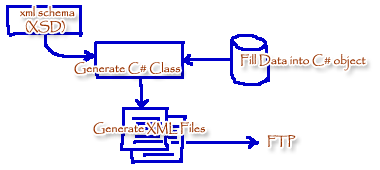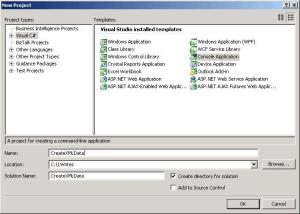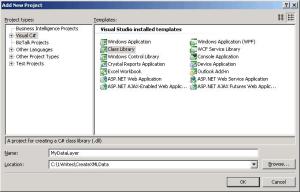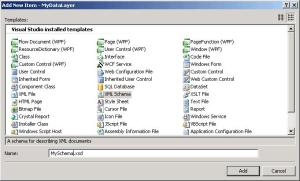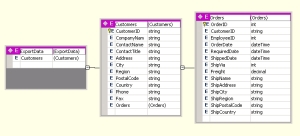I have an XSD file pre defined as shown below:
Using a dataset I populate it as follows:
This produces an output of :
but what I was expecting something like this:
<?xml version="1.0" encoding="UTF-8"?> <xs:schema xmlns:xs="http://www.w3.org/2001/XMLSchema" elementFormDefault="qualified" attributeFormDefault="unqualified"> <xs:element name="Synchro"> <xs:complexType> <xs:sequence> <xs:element name="Titles" minOccurs="0"> <xs:complexType> <xs:sequence maxOccurs="unbounded"> <xs:element name="Name" type="xs:string"/> </xs:sequence> </xs:complexType> </xs:element> </xs:complexType> </xs:schema>
// Create an instance of a dataset DataSet syncDS = new DataSet(); // Assign the schema to the dataset syncDS.ReadXmlSchema(@"c:\temp\Synchro.xsd"); // Populate the tittles table syncDS.Tables["Titles"].Rows.Add("Ms"); syncDS.Tables["Titles"].Rows.Add("Dr"); syncDS.Tables["Titles"].Rows.Add("Professor"); syncDS.Tables["Titles"].Rows.Add("Mr"); syncDS.Tables["Titles"].Rows.Add("Miss"); syncDS.Tables["Titles"].Rows.Add("Sir"); syncDS.Tables["Titles"].Rows.Add("Mrs"); syncDS.Tables["Titles"].Rows.Add("Reverend"); syncDS.WriteXml(@"c:\temp\syncro.xml");
ANSWER
--------------
I have worked out how to solve the problem but I'm not convinced it's the most efficient way of doing things but at least I know it works. Below, I've included some sample code:
// create the root element XElement root = new XElement("Synchro", null); // Add the attributes to the root node root.Add(new XAttribute("SchemaVersion", "1.0.1")); // this is hard coded as it must be changed when the XSD structure changes root.Add(new XAttribute("SynchroDate", DateTime.Today.ToString("yyyy-MM-dd"))); // Now populate the titles element // Create the Titles element XElement Titles = new XElement("Titles", null); //Hard code for test case //Titles.Add(new XElement("Name", "Ms")); //Titles.Add(new XElement("Name", "Dr")); //Titles.Add(new XElement("Name", "Professor")); //Titles.Add(new XElement("Name", "Mr")); //Titles.Add(new XElement("Name", "Miss")); //Titles.Add(new XElement("Name", "Sir")); //Titles.Add(new XElement("Name", "Mrs")); //Titles.Add(new XElement("Name", "Reverend")); // Iterate through the values from a datatable foreach (SyncDataSet.TitlesRow tRow in SyncData.SyncTitles) { // Create a new element node for each title Titles.Add(new XElement("Name", tRow.TitleName)); } // Add the Titles element to the root node root.Add(Titles); // Validate the root node has been populated correctly against the schema XDocument doc = new XDocument(root); XmlSchemaSet schemas = new XmlSchemaSet(); schemas.Add(XmlSchema.Read(new StreamReader(Path.Combine(SettingsEx.Instance.SchemasFolder, "BAHCC_Synchro.xsd")), null)); // set the valid flag to true prior to validation and let the event handler set it to false if it's not valid bool OutputValid = true; // Validate against the schema and set the Output valid flag to false if the xmlSync_validation event handler is called. doc.Validate(schemas, xmlSync_validation); if (OutputValid == true) { // Output the XML to a file root.Save(@"C:\temp\Synchro.xml")); }
<?xml version="1.0" standalone="yes"?> <NewDataSet> <Titles> <Name>Ms</Name> </Titles> <Titles> <Name>Dr</Name> </Titles> <Titles> <Name>Professor</Name> </Titles> <Titles> <Name>Mr</Name> </Titles> <Titles> <Name>Miss</Name> </Titles> <Titles> <Name>Sir</Name> </Titles> <Titles> <Name>Mrs</Name> </Titles> <Titles> <Name>Reverend</Name> </Titles> </NewDataSet>
<Synchro SchemaVersion="1.0.1" SynchroDate="2009-12-11"> <Titles> <Name>Ms</Name> <Name>Dr</Name> <Name>Professor</Name> <Name>Mr</Name> <Name>Miss</Name> <Name>Sir</Name> <Name>Mrs</Name> <Name>Reverend</Name> </Titles> </Synchro> for ref:-
http://social.msdn.microsoft.com/Forums/en-US/adodotnetdataset/thread/4df9785a-8b1f-48c7-9914-1ead9da3ce82/
